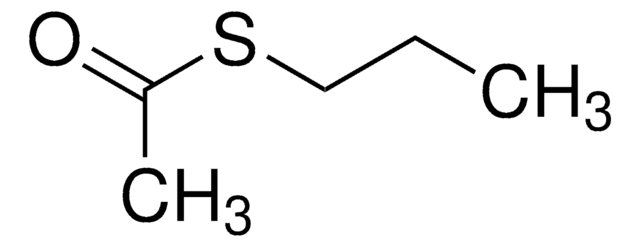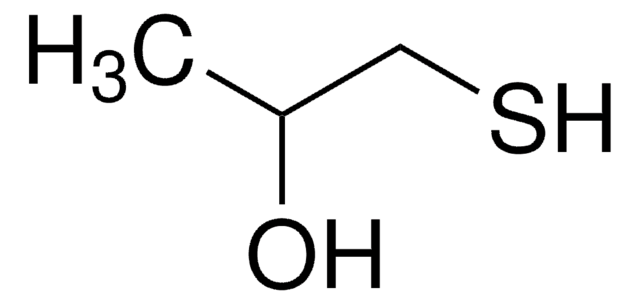W328200
Ethyl thioacetate
≥98%
Synonym(s):
S-Ethyl acetothioate, S-Ethyl ethanethioate, S-Ethyl thioacetate
About This Item
Recommended Products
biological source
synthetic
Agency
meets purity specifications of JECFA
Assay
≥98%
refractive index
n20/D 1.458 (lit.)
bp
116 °C (lit.)
density
0.979 g/mL at 25 °C (lit.)
application(s)
flavors and fragrances
Documentation
see Safety & Documentation for available documents
food allergen
no known allergens
Organoleptic
garlic; onion; fruity; sulfurous
SMILES string
CCSC(C)=O
InChI
1S/C4H8OS/c1-3-6-4(2)5/h3H2,1-2H3
InChI key
APTGPWJUOYMUCE-UHFFFAOYSA-N
Related Categories
General description
Disclaimer
Signal Word
Danger
Hazard Statements
Precautionary Statements
Hazard Classifications
Acute Tox. 4 Oral - Eye Dam. 1 - Flam. Liq. 2 - Skin Irrit. 2 - STOT SE 3
Target Organs
Respiratory system
Storage Class Code
3 - Flammable liquids
WGK
WGK 3
Flash Point(F)
64.4 °F - closed cup
Flash Point(C)
18 °C - closed cup
Personal Protective Equipment
Regulatory Listings
Regulatory Listings are mainly provided for chemical products. Only limited information can be provided here for non-chemical products. No entry means none of the components are listed. It is the user’s obligation to ensure the safe and legal use of the product.
FSL
Group 4: Flammable liquids
Type 1 petroleums
Hazardous rank II
Water insoluble liquid
JAN Code
W328200-100G:4548173976679
W328200-VAR:
W328200-SAMPLE:
W328200-1KG:4548173976686
W328200-25G:4548173976693
W328200-BULK:
Certificates of Analysis (COA)
Search for Certificates of Analysis (COA) by entering the products Lot/Batch Number. Lot and Batch Numbers can be found on a product’s label following the words ‘Lot’ or ‘Batch’.
Already Own This Product?
Find documentation for the products that you have recently purchased in the Document Library.
Our team of scientists has experience in all areas of research including Life Science, Material Science, Chemical Synthesis, Chromatography, Analytical and many others.
Contact Technical Service











